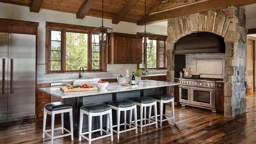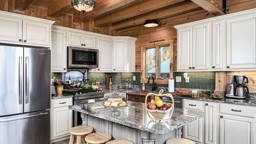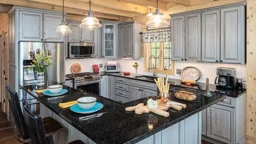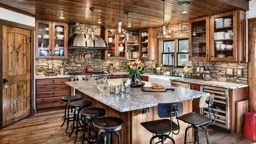
Whether a kitchen is large or small, it's the place everyone loves to congregate. Today, most architects and kitchen designers advise homeowners to plan a kitchen that combines both eating and entertaining areas into one comfortable room. You may even want to include space for a small kitchen office, a tidy craft corner or a cozy reading niche. But attaining an eat-in kitchen that actually works well in your new home requires some planning ahead. Read on for advice from the kitchen experts, and you'll soon be cooking (and dining) in style.
Assess Your Needs
Before you meet with a designer or builder, consider the ways in which you use your present kitchen. Think about how and when your family cooks and eats, as well as their daily routines and hobbies. Is an eat-in kitchen that can host as many diners as a neighborhood bistro useful for the way you really live? Or would you be happier with a space designed for intimate dinners for two? Imagine the things your dream kitchen would make possible. Do you want to be able to accommodate large parties, or are you more concerned about keeping an eye on the kids while you cook?
"Make a chart to record the number of people who dine in the space daily and those who dine there occasionally, and figure out the purpose of the meal — whether it's for quick snacks, socializing over tea, doing homework or sit-down dining," recommends designer Lorey Cavanaugh of Kitchen and Bath Design Consultants in West Hartford, Connecticut, and a member of SEN Design Group, a professional organization of independent kitchen designers. But it's also important to think about the future. "Imagine how your needs might change in five or 10 years," Lorey adds. If your kids are a few years from college, you might be able to swing a smaller space. On the flipside, if you find your circle is expanding with grandkids, think about whether you'll want to host large family get-togethers in the near future.
Designing the Space
How big should your kitchen be? The answer depends on both your budget and your lifestyle. But no matter what size you choose, eliminating walls between the living area and kitchen makes for a more social environment. Plus, an open floor plan provides the perfect opportunity to show off your home's architectural craftsmanship. With timber framing, post-and-beam or hybrid construction, it's easy to reinforce the functional and emotional importance of this central space.
To personalize your eat-in kitchen, consider handcrafted timbers, specialty woods and vaulted ceilings. Exposed posts and beams let you visually distinguish separate areas without intrusive walls. If much of your cooking takes place on a grill, think about selecting a plan with a generously sized deck, porch or balcony directly off the kitchen. Use French or sliding glass doors to create easy access to your grilling area. You might even want to consider investing in an elaborate outdoor kitchen with its own dining space if you're building in a milder climate.
Include Counter Service
Back indoors, a freestanding island or peninsula will draw family and friends toward the cook without creating bottlenecks in the food-prep area. They also provide a place to enjoy breakfast, snacks and casual meals. If you desire a large island, keep in mind that the National Kitchen and Bath Association recommends a 39-inch walkway between counter seating and walls or cabinets.
That way, seated diners will have plenty of space to enjoy their meals without getting a cabinet door in the noggin. Countertop heights can be varied in numerous ways to efficiently provide a dining space in a cozy kitchen. One popular configuration is to design an island or breakfast bar with a food-prep surface on the kitchen side and higher, pub-table-height seating on the other.
For a seamless look, match your island to your main cabinetry and counters. "Contrast the base and countertop for a unique look," suggests Nina Hackel, president of Nashua, New Hampshire-based Dream Kitchens and also a member of SEN Design Group. For example, a freeform wood surface with joinery details perched atop a river-rock-faced base creates an eye-catching focal point.
Reserve a Dinner Table
While eating counters are useful, in most cases they're not meant to replace a dining table and chairs. Whether you choose an open-concept floor plan or a traditional layout, almost every kitchen has room for a table, asserts Rob D'Allesandro of New Energy Works Timber Frames.
Opt for an expansive great room and you can place a long farmhouse table along one side of the cooking area, between the kitchen and living area. In plans with a separate dining room, a round table tucked into a corner or alcove might be a better fit. If your family usually eats breakfast in shifts, you may only need enough room for two barstools at the counter, which will carve out space for a large dining table that works for both evening meals and holiday feasts. Working with a floor plan that's low in square footage? Reducing counter length can often create enough space for a table. Or, better yet, build in your dining area to save space. Built-in banquettes are one option.
To eliminate the need for traffic paths on two sides, an L-shape bench can be used in smaller kitchens, according to another SEN designer, Susan Palmquist of Sawhill Custom Kitchens and Design in Minneapolis. Susan also suggests placing drawers under the seat to provide additional storage space. Most floor plans can be modified to accommodate a bump-out or bay window that creates a cozy table alcove. If you can, position your table and chairs to take advantage of a spectacular view rather than the cooking or clean-up area. And make sure when planning the dimensions for an eating nook to allow at least 18 inches, and preferably 24 inches, of elbowroom for each diner.
Big or little, elaborate or simple, just make sure that you love your eat-in kitchen. By assessing your family's lifestyle and planning for your needs and dreams, you might find that, like your guests, the kitchen is your favorite space, too.











